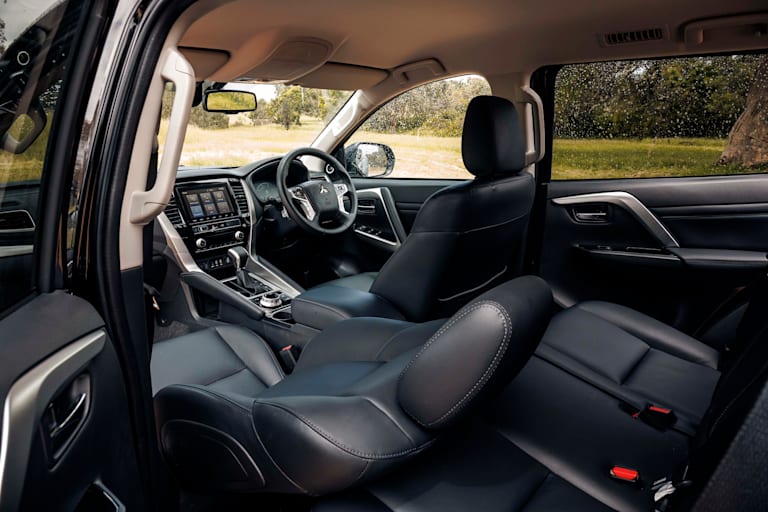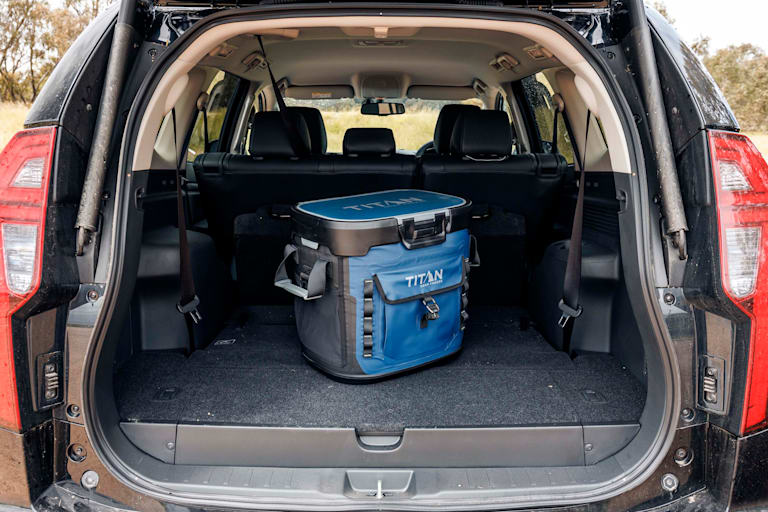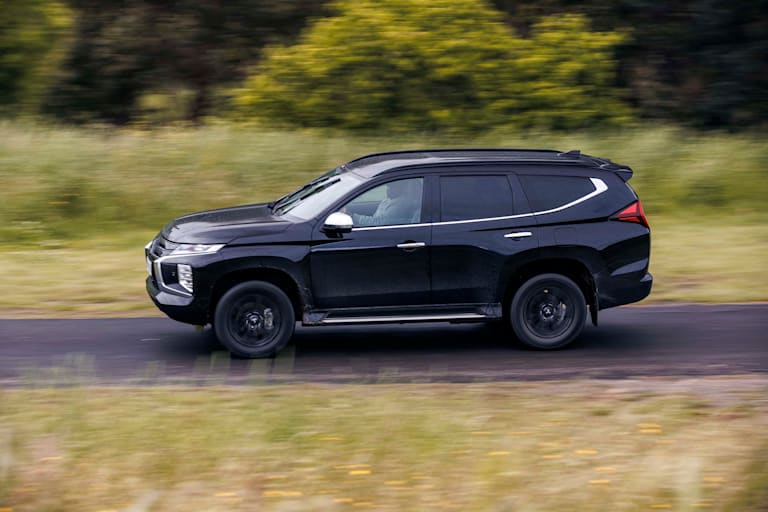
Score breakdown
Things we like
- Industry-leading warranty and servicing
- Comfy for road trips and weekends away
- Adept off-road
Not so much
- Interior feels old
- Price hike above the Exceed and GLS
- Glitchy powered tailgate
The ute-based Pajero Sport platform may seem a bit long in the tooth, and that’s because it is. This current platform was released seven years ago in 2015, with a mid-life update in 2020 feeding the SUV wagon with a generous helping of cosmetic niceties including a new-look ‘Dynamic Shield’ front end.
The blacked-out GSR model you’re currently ogling is the most recent addition to the local line-up, released earlier in 2022 to take the helm as the most premium Paj Sport in Australia.
The GSR is the top Pajero Sport variant in an Australian line-up that comprises the GLX, GLS and Exceed. Five- and seven-seat models are available throughout the range, but the GSR is sold as a seven-seater only.
Essentially an Exceed with a smattering of blacked-out cosmetic features, is the GSR worth the extra coin? Let’s take a closer look.
JUMP AHEAD
- How much is it, and what do you get?
- How do rivals compare on value?
- Interior comfort, space and storage
- What is it like to drive?
- How much fuel does the Pajero Sport GSR use?
- How safe is it?
- Warranty and running costs
- VERDICT
- Specifications
How much is it, and what do you get?
The GSR is the top-of-the-line Pajero Sport variant on sale in Australia, available at a pinch over $60K at $61,440.
It’s only available with Mitsubishi's Super Select II 4WD system and with seven seats, so if you want a five-pew Pajero Sport with Mitsubishi's Super Select II 4WD system, you'll need to opt for the GLX five-seater.

The entire ute-based Pajero Sport range utilises the same 2.4-litre turbo-diesel engine that powers the Triton. The four-cylinder makes 133kW and 433Nm, which are modest digits when compared to the all-new Everest (154kW-500Nm). It is mated to an eight-speed automatic transmission - no third pedal with the Paj Sport, unfortunately.
In addition to the Super Select II 4WD system, GSR models, as well as GLS and Exceed 4WD variants, all come with a rear diff lock as standard.
What differentiates the GSR from the rest of the Pajero Sport range is the addition of black treatment, and plenty of it. The GSR gets 18-inch black alloy wheels, a black rear spoiler, black front and rear bumper garnishes, black headlight garnish, a black grille, two-tone roof (black), and a black Pajero Sport bonnet emblem.
How do rivals compare on value?
At its $60,000 price point, the Pajero Sport GSR undercuts the all-new mid-spec Everest Trend but costs slightly more than the base-spec Ambiente. Comparing apples with apples, the top-spec GSR will yield a saving of more than $15K when pitted against the top-spec Everest Platinum.
Other competitors in the large SUV bracket include the Isuzu MU-X, which in top-spec LS-T guise costs a fraction under $66,000, and the ever-popular Toyota Prado which is a sales juggernaut and costs $60,830 in base-spec GX trim. Opt for the Prado Kakadu and you’re looking to spend around $90,000 … at least.
So for a top-spec off-road-ready vehicle that’s loaded with kit and features, the $61,440 asking price of the GSR starts to look appealing. Still, the lingering question of whether the GSR offers enough over and above its Exceed and GLS stablemates remains.
Interior comfort, space and storage
Where the Pajero Sport most clearly shows its age is inside the cabin, most notably with the eight-inch touchscreen which is small by modern standards and the UI feels generations old when in operation.
Embedded TomTom navigation is standard, but, if you’re anything like us, you’ll never turn it on thanks to the inclusion of Apple CarPlay and Android Auto. On a positive note, it’s easy to find and scroll through apps and functions due to its user-friendly interface, and the premium eight-speaker sound system provides dulcet tunes.

The use of touchscreen buttons makes it difficult to pinpoint input at times, and the use of ‘actual’ buttons and dials would make life a helluva lot easier.
USB power supplies are fitted for front- and second-row passengers, as well as 12V accessory sockets. A 220V power outlet is positioned in the third row.
Despite looking narrow to the naked eye, the front leather-appointed pews of the GSR provide a comfortable and spacious abode for long stints behind the wheel - and not only because they’re heated. The third row does get a little cramped for taller passengers, and getting in and out is not an easy task. With the third row in place, the GSR has 131 litres of space in the rear; opting to fold down the third row lifts that to 502 litres; and popping all the rear seats down creates 1488 litres of space.
A payload capacity of just 650kg limits how much gear you can carry, though.

There are six cupholders, four bottle holders and plenty more storage bins including a clever use of otherwise wasted space beneath the centre console. A rear floor storage box will also prove extremely useful.
As a side note, we experienced a glitchy powered tailgate, an issue we encountered when reviewing the Pajero Sport GLS and also something that was noted in our long-term review of the GLS Deluxe. That it is a recurring issue suggests it mightn’t be user error.
What’s it like to drive?
The Pajero Sport’s ability to adapt to both tarmac and dirt is one of its most endearing attributes. Its 2.4-litre MIVEC DID turbo-diesel engine may be slightly underpowered in its attempt to push the GSR’s hefty 2125kg kerb weight, and you can hear it working its backside off to do so, but it’s not a mitigating factor.
The GSR is also not the most refined nor quiet when travelling on long stretches of bitumen, but its ladder-frame chassis comprises coils front and rear, so it’s a much nicer on-road performer than the ute it’s based on. The eight-speed automatic transmission also feels well-calibrated and smooth by large SUV standards.

The GSR wears 18 x 7.5 black alloy wheels inside 265/60R18 110H Toyo Open Country A32s made specifically for the Pajero Sport.
As mentioned, the Pajero Sport comes with Mitsubishi’s Super Select II 4WD system, which is simple to operate via an easy-to-access dial on the centre console, and it allows the user to tailor the vehicle’s dynamics to the conditions.
Mitsubishi also offers a Remote Smartphone App, which allows the owner to operate the tailgate and monitor vehicle information including fuel consumption. Plus, it has a car-finder function.
How is it on fuel?
The Pajero Sport is equipped with a 68-litre fuel tank, and Mitsubishi lists the GSR as consuming 8.0 litres of diesel per 100km. On our test, we guzzled closer to 9.0L/100km, which is still quite frugal.
For comparison’s sake, on a recent comparison test between the Ford Everest Platinum and Toyota Prado Kakadu, the Everest drank 11.3L/100km and the Prado 10.6L/100km.
How safe is it?
The entire Pajero Sport range received a five-star ANCAP safety rating when released back in 2015 - albeit under more lenient guidelines than today’s standards.
In 2020, as part of its mid-life update, Mitsubishi added Lane Change Assist (LCA) and Rear Cross Traffic Alert (RCTA) as standard on Exceed models. Blind-spot warning, rear cross-traffic alert and lane-departure warning are now exclusive to Exceed and GSR variants.
The GSR is equipped with parking assistance in the form of a multi-around monitor, a rear-view camera, and front and rear parking sensors.
Safety kit includes
| Forward Collision Mitigation system (FCM) |
| Emergency Stop Signal function (ESS) |
| Emergency Brake Assist system (EBA) |
| Hill Start Assist (HSA) |
| Hill Descent Control (HDC) |
| Active Stability Control (ASC) |
| Trailer Stability Assist (TSA)2 |
| Active Traction Control (ATC) |
| Anti-lock Braking System (ABS) |
| Electronic Brakeforce Distribution (EBD) |
| Brake Override System (BOS) |
| Adaptive Cruise Control (ACC) |
| Lane Change Assist (LCA) |
| Rear Cross Traffic Alert (RCTA) |
| Lane Departure Warning |
| Blind-spot monitoring |
Warranty and running costs
Mitsubishi is industry leading when it comes to after-sales support, with all Mitsubishi vehicles covered by a five-year/100,000km vehicle warranty.
That extends to a 10-year or 200,000km warranty if owners stay on top of their scheduled servicing within the Mitsubishi network.
Servicing intervals are every 12 months or 15,000km, whichever comes first. Mitsubishi will also cap servicing costs for the first ten years or 150,000km.
Verdict
The Pajero Sport is a compelling vehicle for its versatility as a family hauler slash weekend adventure machine. Its competency to take you from the 9 to 5 grind to a campsite on the edge of a map makes it hard to ignore.

Plus, getting all of this in a package that costs around $60K makes it money well spent. If the Pajero Sport is a vehicle that ticks your boxes, though, we’d pocket the $10K and opt for the seven-seat GLS 4x4 variant. Unless blacked-out trim is a high priority, of course.
2022 Mitsubishi Pajero GSR specs
| Engine | 2.4L I4 turbo-diesel |
| Capacity | 2442cc |
| Transmission | 8-speed automatic |
| Power | 133kW @ 3500 |
| Torque | 430Nm @ 2500 |
| 4x4 system | Part-time 4x4 |
| Front suspension | Double wishbone with coils |
| Rear suspension | 3-link with coils |
| Wheels | 18-inch alloys |
| Kerb weight | 2125kg |
| GVM | 2775kg |
| Payload | 650kg |
| Towing capacity | 3100kg |
| Seating | 7 |
| Fuel tank | 68 |
| ADR fuel claim | 8.0L/100km |
| Wading depth | 700mm |
| Approach angle | 30 |
| Departure angle | 24.2 |
| Rampover angle | 23.1 |
| Ground Clearance | 218mm |
| Price | $61,440 |
Score breakdown
Things we like
- Industry-leading warranty and servicing
- Comfy for road trips and weekends away
- Adept off-road
Not so much
- Interior feels old
- Price hike above the Exceed and GLS
- Glitchy powered tailgate


COMMENTS